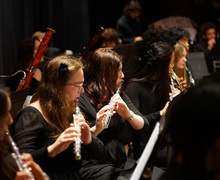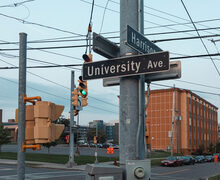Indigenous organizers continue advocacy for Columbus statue removal
Emma Folts | Managing Editor
At a rally on June 27, the movement issued a two-day deadline for the city to remove the statue of Columbus, who enslaved and killed Indigenous peoples.
The Daily Orange is a nonprofit newsroom that receives no funding from Syracuse University. Consider donating today to support our mission.
The Resilient Indigenous Action Collective is continuing to push Syracuse officials to take down a statue of Christopher Columbus nearly a month after its deadline for the monument’s removal.
Since its inception in June, the collective—composed of a group of Indigenous people who live in the city of Syracuse and across New York state—has campaigned for Mayor Ben Walsh to take down the statue of Columbus in downtown Syracuse’s Columbus Circle.
The movement at a rally June 27 issued a two-day deadline for the city to remove the statue of Columbus, who enslaved and killed Indigenous peoples. Nearly a month later, the monument remains standing.
RIAC has since renewed its social media campaign to have the statue removed. The collective will continue its campaign against the Columbus statue until the city takes the monument down, said organizer Ionah Scully, who is Cree-Métis of the Michel First Nation.
“For decades, we’ve been ready to have that statue down,” Scully said. “It’s not that hard of a decision given what’s going on in the current (political) climate.”
Across the country, residents have taken down or called for the removal of monuments to Confederate soldiers and other racist historical figures. A petition to remove the Columbus statue in Syracuse collected over 17,000 signatures as of Wednesday.
Walsh attended the rally June 27 and heard the collective’s 48-hour deadline, Scully said. The day before the rally, the mayor announced he would create a Columbus Circle Action Group—which would include Indigenous people—to advise him on the development of an education and heritage site in the circle.
While Walsh said Columbus Circle will change, whether the Columbus statue will remain as part of the renovated site has not yet been determined.
Members of the Onondaga Nation have campaigned to remove the statue for decades, Scully said. But the Indigenous community has been mostly left out of the dialogue surrounding the statue for the past few years, they said.
Italian-Americans in Syracuse funded the statue’s construction in the 1920s, a point of contention in local discussions on the monument’s removal. But to Indigenous people, the statue represents a painful history and is a detriment to their mental health, Scully said.
The imagery of the statue—which includes a plaque depicting Indigenous people bowing to Columbus—shows a false, white supremacist view of history, said Ethan Tyo, an organizer who is of Akwesasne Mohawk Territory.
Indigenous peoples, including the Taíno people of the Caribbean, died in mass from murder, enslavement and disease as a result of Columbus’ arrival.
“We’re in this point where we have knowledge, we have books, we have facts,” Tyo said. “(Taking down the statue is) not removing history, it’s not rewriting history. It’s enlightening history. It’s bringing the other perspective of history and decolonizing it.”
RIAC is focused on more than the removal of the statue in Syracuse, Tyo said. The group also hopes to leverage its online presence to raise money for Indigenous people in need, educate people about Indigenous culture and organize Indigenous people to address issues affecting their community.
“This isn’t just a Columbus group,” Tyo said. “We really want to help spread knowledge, educate, advocate and help with organizing for other indigenous people and communities.”
Members of RIAC created the group so the Indigenous community could march together against racial injustice, Scully said. Indigenous people experience high levels of violence and police brutality and have been disproportionately impacted by the coronavirus pandemic, they said.
Indigenous people from across the country have expressed interest in joining the collective since its formation, said organizer Danielle Smith of the Onondaga Nation. The group plans to hold a general interest meeting possibly in the next couple weeks, she said.
Organizing into a collective gives Indigenous people in central New York a means to amplify their voice to be heard in future discussions, Smith said.
“You have support from other people who have the same vision as you,” she said. “And then also using that as a way to hold each other accountable.”
Published on July 30, 2020 at 1:33 pm
Contact Abby: akweiss@syr.edu | @abbyweiss_21






